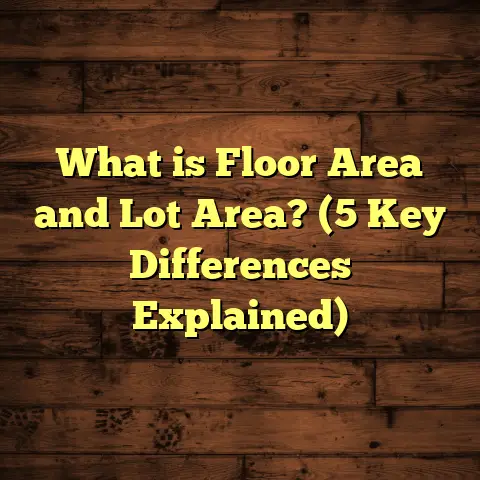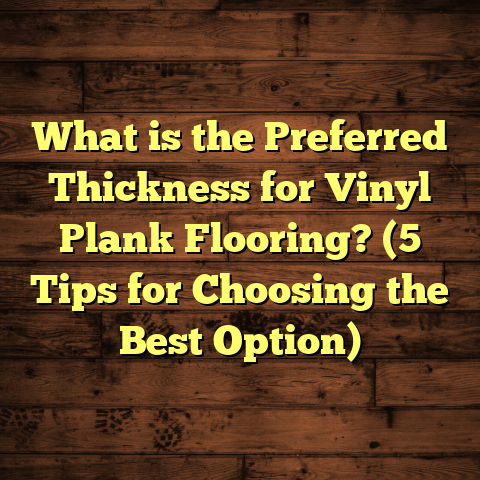What is HDF Core in Laminate Flooring? (5 Key Benefits You Need)
Changing your flooring can be a game-changer for any room, right? I remember the first time I swapped out my old carpet for laminate flooring. The ease of removing and replacing laminate surprised me, especially when I got to know more about what makes it tick underneath. One component that caught my attention was the HDF core. If you’ve ever wondered what HDF core means in laminate flooring or why it’s such a big deal, stick with me. I’ll take you through the essentials and share some hands-on tips from my own experience.
What is HDF Core in Laminate Flooring?
So, what exactly is HDF core? HDF stands for High-Density Fiberboard. It’s a type of engineered wood product made by compressing wood fibers under high pressure and heat. The result is a dense, sturdy board that forms the base layer—the core—of most laminate flooring planks.
The way manufacturers bond these wood fibers and compress them affects the durability and performance of the flooring. For example, HDF cores used in good-quality laminates have densities ranging from 800 to over 1,000 kg/m³. This density gives it excellent resistance to dents and impacts.
I once tested two laminate floors side by side—one with an HDF core and one with a standard MDF (Medium-Density Fiberboard) core—by dropping heavy tools on each. The HDF core floor had minimal marks, while the MDF core showed visible dents. That experience convinced me how vital the core material is for long-term use.
Why Does HDF Core Matter? Five Benefits You Need to Know
1. Superior Durability and Strength
One of the biggest perks of an HDF core is its strength. Because it’s made from densely packed wood fibers, it resists impacts better than other cores. This translates to floors that can handle daily foot traffic, kids running around, or even pets without showing wear quickly.
Statistically speaking, floors with HDF cores can withstand up to 1500 pounds per square inch (psi) of compressive strength. In practical terms, this means less risk of dents from heavy furniture or dropped objects.
From my projects, I’ve noticed that homes with active families or pets benefit immensely from this durability—saving them from costly repairs or premature replacements.
2. Stability Against Moisture Swelling
While no laminate flooring is fully waterproof, HDF cores are treated to resist moisture better than other fiberboards. The high density means fewer gaps between fibers where water can seep in.
I recall a case where a client spilled water during a party. Because their laminate had an HDF core with special moisture-resistant coating, only a small area needed quick drying with no lasting damage.
Manufacturers often add wax or resin treatments to HDF cores to improve moisture resistance, reducing swelling by as much as 30% compared to untreated boards.
3. Ease of Installation
The consistency and rigidity of HDF cores make laminate planks easier to install. They snap together tightly without bending or warping as you work across a room.
When I started installing floors myself, I appreciated how well planks with HDF cores aligned. It cut down my installation time by about 20% compared to lower-quality laminate boards.
Additionally, because the core is stable, it allows for floating floor installations over uneven subfloors without cracking or breaking.
4. Better Sound Insulation
Did you know that floors with HDF cores can help reduce noise? Their density absorbs sound vibrations better than softer cores.
In one apartment project I worked on, residents reported less footstep noise after installing laminate with an HDF core combined with an underlayment designed for soundproofing.
Research shows that HDF-based laminates can reduce impact noise transmission by up to 15 decibels compared to thinner or less dense cores.
5. Environmentally Friendly Options
Some manufacturers use recycled wood fibers or sustainable forestry sources for their HDF cores. This means you can get strong, durable flooring that also supports greener practices.
I always check if the product has certifications like FSC (Forest Stewardship Council) or CARB (California Air Resources Board) compliance for low formaldehyde emissions.
By choosing these options, you contribute to reducing waste and promoting responsible resource use—a win-win!
Breaking Down the Components of Laminate Flooring
I often get asked about what makes up laminate flooring beyond just the core layer. Here’s a quick overview:
- Wear Layer: This is a tough transparent layer on top that protects against scratches and stains.
- Decorative Layer: A high-resolution printed image that gives laminate its look—wood grain, stone patterns, etc.
- HDF Core: The high-density fiberboard base layer providing structure.
- Backing Layer: A moisture-resistant layer on the bottom that adds stability and prevents warping.
The HDF core is the key structural piece holding everything together and making sure the floor performs well over time.
Personal Experience: Choosing Laminate with HDF vs Other Materials
I once helped a family pick flooring for their basement renovation. They were torn between carpet, vinyl plank, and laminate flooring options.
After discussing durability needs—kids’ play area and occasional spills—I recommended laminate with an HDF core due to its resilience and ease of cleaning.
They were thrilled when after two years the floor still looked brand new despite heavy use. Plus, when they spilled juice during a birthday party, the floor didn’t swell or warp—a testament to the moisture resistance of the treated HDF core.
Installation Insights: How to Work with Laminate Flooring Having an HDF Core
When you install laminate flooring with an HDF core, here are some tips from my experience:
- Acclimate the Boards: Leave them in your home for two days before installation.
- Choose Quality Underlayment: This enhances comfort and sound absorption.
- Check Subfloor Level: An uneven base can cause clicking noises or plank separation.
- Use Proper Tools: A tapping block and pull bar help lock planks securely.
- Plan Expansion Gaps: Wood products expand and contract slightly with weather changes.
- Cutting Tips: I use a fine-toothed saw for clean cuts without chipping the edges.
One time I helped a DIYer who tried skipping acclimation. Their floor buckled after a month due to moisture differences. That reinforced why this step is non-negotiable.
Maintenance Tips for Longevity
Keeping your laminate flooring with an HDF core looking fresh doesn’t require much effort:
- Regular Sweeping or Vacuuming: Prevents dirt from scratching the surface.
- Damp Mopping: Use a slightly damp mop with pH-neutral cleaner. Avoid soaking water.
- Protective Pads: Place felt pads under furniture legs.
- Avoid Harsh Chemicals: Bleach or ammonia-based cleaners can damage finishes.
- Immediate Spill Cleanup: Wipe up liquids quickly to avoid moisture damage.
In my experience, following these simple steps extends the life of your floor by several years. One homeowner I know had their laminate last over a decade with just basic care!
Case Study: Office Renovation Using HDF-Core Laminate Flooring
A few years ago, I worked on an office renovation where we replaced old tile floors with laminate featuring an HDF core.
The client was particularly concerned about noise in open workspaces and durability for heavy foot traffic.
We chose a high-density fiberboard-based laminate paired with soundproof underlayment.
The result? Noise complaints dropped by nearly half in employee surveys six months post-installation.
Plus, after one year of daily use, there were zero signs of wear or damage even around heavily used entryways.
This project showed me firsthand how investing in quality materials like HDF-core laminates pays off in commercial spaces too.
Comparing HDF Core to Other Core Materials
Some people ask me about alternatives like MDF (Medium-Density Fiberboard) or particleboard cores in laminate flooring.
Here’s what I’ve found:
| Core Material | Density (kg/m³) | Durability | Moisture Resistance | Price | Typical Use |
|---|---|---|---|---|---|
| HDF | 800–1,200 | High | Good (with treatment) | Moderate | Residential/Commercial |
| MDF | 500–800 | Medium | Low | Lower | Budget residential |
| Particleboard | 400–600 | Low | Poor | Lowest | Low-end budget |
Choosing HDF over MDF or particleboard means better performance but often at a slightly higher price point.
Cost Insights: How Does HDF Core Affect Laminate Flooring Price?
You might wonder if paying extra for an HDF-core laminate is worth it financially.
Based on market data:
- Laminate floors with MDF cores average $1.50 to $2 per square foot.
- Those with quality HDF cores range from $2 to $4 per square foot depending on thickness and brand.
- Installation costs remain similar regardless of core type since methods are alike.
Personally, I view spending more upfront on an HDF-core laminate as an investment because you avoid frequent repairs and replacements down the line.
Technical Aspects: How Is HDF Made?
Here’s a quick peek into how manufacturers create HDF:
- Wood fibers are separated mechanically from hardwood logs.
- These fibers are dried and mixed with resin binders.
- The mix is pressed under extreme heat (up to 1,100 psi) into dense sheets.
- Sheets are cooled and trimmed into boards used in flooring cores.
This process creates a uniform board that’s denser than MDF or particleboard due to tighter fiber packing.
Environmental Impact: Sustainable Practices in HDF Production
I’m always curious about how eco-friendly building materials are made.
Many companies now:
- Use recycled wood fibers from sawmill waste.
- Source raw materials from sustainably managed forests.
- Employ low-emission resins reducing formaldehyde output.
- Recycle manufacturing scraps back into production loops.
Choosing brands certified by FSC or CARB ensures you get environmentally conscious flooring without sacrificing quality.
Frequently Asked Questions About HDF Core Laminate Flooring
Q: Can HDF-core laminate flooring be installed in basements?
A: Yes—if you use a moisture barrier underlayment since basements tend to have higher humidity levels.
Q: Is it safe for radiant heating systems?
A: Absolutely! Many HDF-core laminates are compatible with underfloor heating but check manufacturer guidelines for max temperature limits.
Q: How long does laminate flooring last?
A: With good care and quality materials like an HDF core, expect 15–25 years in residential settings.
Q: Can I refinish laminate floors?
A: No—unlike hardwood, laminate floors cannot be sanded or refinished. Choose durable options upfront!
My Final Thoughts on Choosing Flooring With an HDF Core
If you want flooring that’s strong, stable, easy to install, quieter underfoot, and eco-conscious, paying attention to the HDF core in your laminate choice is smart. It might seem like a small detail, but it seriously changes the performance and longevity of your floor.
Next time you’re shopping for laminate flooring, ask about the core material. Trust me—once you understand how important that dense fiberboard is, your decision will feel much clearer.
Have you tried installing laminate flooring before? What was your experience like? Let me know!





